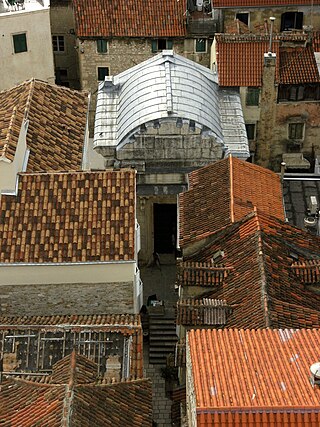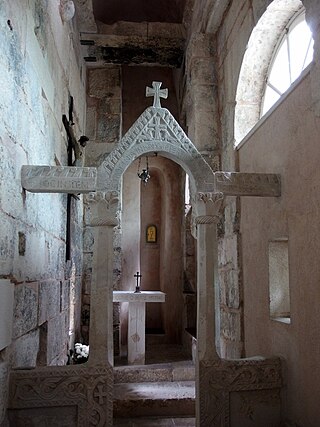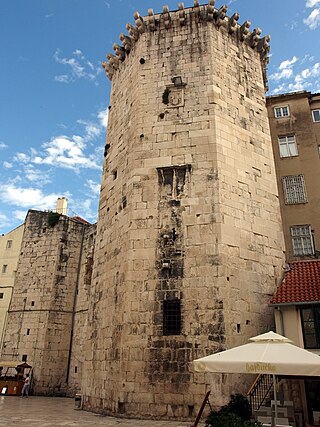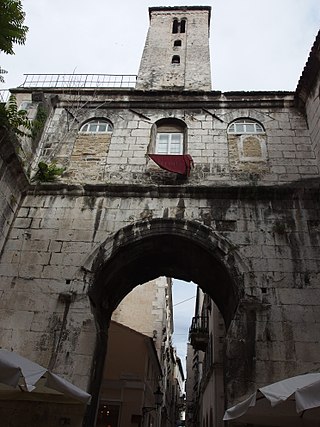
Diocletian's Palace is an ancient palace built for the Roman emperor Diocletian at the end of the third century AD, which today forms about half of the old town of Split, Croatia. While it is referred to as a "palace" because of its intended use as the retirement residence of Diocletian, the term can be misleading as the structure is massive and more resembles a large fortress: about half of it was for Diocletian's personal use, and the rest housed the military garrison.

Frane Bulić was a Croatian priest, archaeologist, and historian.

The Krka Monastery is a Serbian Orthodox monastery dedicated to the Archangel Michael, located near the river Krka, 3 kilometres (1.9 mi) east of Kistanje, in central Dalmatia, Croatia. It is the best known monastery of the Serbian Orthodox Church in Croatia and it is officially protected as part of the Krka National Park. It was established around 1577 or later on the ground of previous Gothic-Romanesque style Catholic church.

The Church of the Holy Salvation or Holy Saviour was a Pre-Romanesque church in the Dalmatian Hinterland, Croatia, whose ruins are now a historic site. It is located in the small village of Cetina, near the spring of the river Cetina, 8 km northwest from the town of Vrlika.

The Cathedral of Saint Domnius, known locally as the Sveti Dujam or colloquially Sveti Duje, is the Catholic cathedral in Split, Croatia. The cathedral is the seat of the Archdiocese of Split-Makarska, headed by Archbishop Marin Barišić. The Cathedral of St. Domnius is a complex of a church, formed from an Imperial Roman mausoleum, with a bell tower; strictly the church is dedicated to the Virgin Mary, and the bell tower to Saint Domnius. Together they form the Cathedral of St. Domnius.

Croatian Pre-Romanesque art and architecture or Old Croatian Art is Pre-Romanesque art and architecture of Croats from their arrival at Balkans till the end of the 11th century when begins the dominance of Romanesque style in art; that was the time of Croatian rulers.

Stradun or Placa is the main street of Dubrovnik, Croatia. The limestone-paved pedestrian street runs some 300 metres through the Old Town, the historic part of the city surrounded by the Walls of Dubrovnik.

Trpimir I was a duke in Croatia from around 845 until his death in 864. He is considered the founder of the Trpimirović dynasty that ruled in Croatia, with interruptions, from around 845 until 1091. Although he was formally vassal of the Frankish Emperor Lothair I, Trpimir used Frankish-Byzantine conflicts to rule on his own.
The Church of Our Lady of Rosary is a Roman Catholic church in Vrlika, Croatia. It is located in the center of town.

Saint Mary's Church, later Sultan Suleiman's Mosque or Fethija, was a place of worship in Jajce, Bosnia and Herzegovina. Along with the remnants of the adjoining Saint Luke's Bell Tower, it is a national monument of Bosnia and Herzegovina. The buildings are located in the historic centre of the city of Jajce, at the foot of the citadel.

The Temple of Jupiter(Croatian: Jupiterov hram) is a temple in Split, Croatia dedicated to the Ancient Roman god Jupiter. It is located in the western part of Diocletian's Palace near the Peristyle, the central square of the imperial complex. It was built between 295 and 305, during the construction of the Palace, and was probably turned into a Baptistery of St. John the Baptist in the 6th century, at the same time when the crypt dedicated to St. Thomas was built. Before the entrance to the Temple is one of the twelve sphinxes brought from Egypt by Emperor Diocletian. Scottish architect Robert Adam considered this temple to be one of Europe's most beautiful monuments.

Church of Holy Trinity is a Pre-Romanesque style Roman Catholic church located in Split, Croatia. Out of all early-medieval architectural monuments in Dalmatia, which historians date back to the period between 8th and 11th century, Church of Holy Trinity, with its original shape and rich findings, has a very important place. This small central edifice with six-leaf structure of semicircular arches strung around irregular circle has become one of the most precious heritage monuments of Split and Dalmatia.

St. Martin's Church is a Roman Catholic church in Split, Croatia. Built into a small space within the ancient Golden Gate of Diocletian's northern wall, it is one of the oldest churches in the city. St. Martin's Church is one of Split's tourist attractions and is known for its fine 11th century chancel screen. It is currently in the care of the Dominican sisters, who have a monastery next door. The church itself is open to public visits.

The Venetian Castle was a medieval castle built during the 15th century in Split, present-day Croatia. Built just south-west of the Diocletian's Palace along the shoreline, the castle had an irregular pentagonal shape with three towers facing north and overlooking the city. The decision to build the castle was made in 1424, however, it wasn't until 1441 that it was actually built on the grounds of a demolished monastery. By the early 16th century, the castle was in poor condition and it wasn't until the first half of the 17th century that work on improving it began.

The Golden Gate, or "the Northern Gate", is one of the four principal Roman gates into the stari grad of Split. Built as part of Diocletian's Palace, it served as the main gate through which the Emperor entered the complex and was elaborately decorated to mark its status. Over the course of the Middle Ages, the gate was sealed off and lost its columns and statuary. It was reopened and repaired in modern times and now serves as a tourist attraction.

The Iron Gate, or "the Western Gate", is one of the four principal Roman gates into the stari grad of Split that was once Diocletian's Palace. Originally a military gate from which troops entered the complex, the gate is the only one to have remained in continuous use to the present day.

The Silver Gate, or "the Eastern Gate", is one of the four principal Roman gates into the stari grad of Split that was once Diocletian's Palace. The gate faces east towards the Roman town of Epetia, today Stobreč.

The Vestibule, also known as The Rotonda or The Atrium, is the first section of the imperial corridor in Diocletian's Palace that led from the Peristyle, which was once the formal entrance to the imperial apartments.

The Cellars of Diocletian's Palace, sometimes referred to as the "basement halls", is a set of substructures, located at the southern end of Diocletian's Palace, that once held up the private apartments of Emperor Diocletian and represent one of the best preserved ancient complexes of their kind in the world.

Church of the Visitation of the Blessed Virgin Mary is a catholic church located in Voćin, Croatia.























